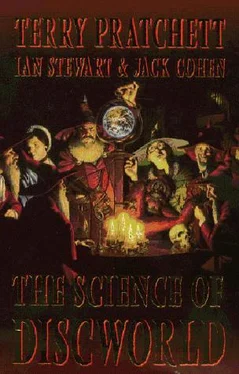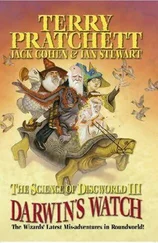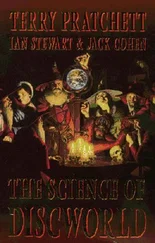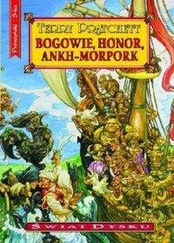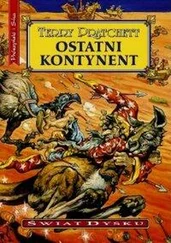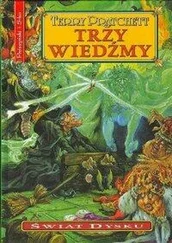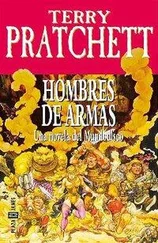Terry Pratchett - Science of Discworld
Здесь есть возможность читать онлайн «Terry Pratchett - Science of Discworld» весь текст электронной книги совершенно бесплатно (целиком полную версию без сокращений). В некоторых случаях можно слушать аудио, скачать через торрент в формате fb2 и присутствует краткое содержание. Жанр: Фантастика и фэнтези, на английском языке. Описание произведения, (предисловие) а так же отзывы посетителей доступны на портале библиотеки ЛибКат.
- Название:Science of Discworld
- Автор:
- Жанр:
- Год:неизвестен
- ISBN:нет данных
- Рейтинг книги:4 / 5. Голосов: 1
-
Избранное:Добавить в избранное
- Отзывы:
-
Ваша оценка:
- 80
- 1
- 2
- 3
- 4
- 5
Science of Discworld: краткое содержание, описание и аннотация
Предлагаем к чтению аннотацию, описание, краткое содержание или предисловие (зависит от того, что написал сам автор книги «Science of Discworld»). Если вы не нашли необходимую информацию о книге — напишите в комментариях, мы постараемся отыскать её.
Science of Discworld — читать онлайн бесплатно полную книгу (весь текст) целиком
Ниже представлен текст книги, разбитый по страницам. Система сохранения места последней прочитанной страницы, позволяет с удобством читать онлайн бесплатно книгу «Science of Discworld», без необходимости каждый раз заново искать на чём Вы остановились. Поставьте закладку, и сможете в любой момент перейти на страницу, на которой закончили чтение.
Интервал:
Закладка:
The most striking feature of humans is the size of our brains: bigger, in comparison to body weight, than any other animal. Strikingly bigger. A detailed story of what makes us human must be extraordinarily complicated, but it's clear that big, powerful brains were the main invention that made it all possible. So we now have two obvious questions to think about: 'Why did we evolve big brains?' and 'How did we evolve big brains?'
The standard theory addresses the 'why'. It maintains that we evolved out on the savannahs, surrounded by lots of big predators, lions, leopards, hyenas, and without much cover. We had to become smart in order to survive. Rincewind would instantly see one flaw in this theory: 'If we were so smart, why did we stay on the savannahs, surrounded by lots of big predators?' But, as we've said, it fits the fossil evidence. The unorthodox theory addresses the 'how'. Big brains need lots of brain cells, and brain cells need lots of chemicals known as 'essential fatty acids'. We have to get these from our food, we can't build them ourselves from anything simpler, and they're in short supply out on the savannahs. However, as Michael Crawford and David Marsh pointed out in 1991, they are abundant in seafood.
Nine years earlier Elaine Morgan had developed Alister Hardy's theory of the 'aquatic ape': we evolved not on the savannahs, but on the seashore. The theory fits a number of human peculiarities: we like water (newborn babies can swim), we have a funny pattern of hair on our bodies, and we walk upright. Go to any Mediterranean resort and you see at once that an awful lot of naked apes think that the seashore is the place to hang out.
Brains are fascinating. They are the physical vehicle for minds, which are even more interesting. Minds are (or, at least, give their owners the vivid impression that they are) conscious, and they have (or, at least, give their owners the vivid impression that they have) free will Minds operate in a world of 'qualia', vivid sense impressions like red, hot, sexy. Qualia aren't abstractions: they are 'feelings'. We all know what it's like to experience them. Science has no idea what makes them the way they are.
Brains, though ... we can make progress on brains. On one level, brains are a kind of computational device. Their most obvious physical components are nerve cells, arranged in complicated networks. Mathematicians have studied such networks, and they find that what networks do is to carry out interesting processes. Give them an input and they will produce an output. Allow their interconnections to evolve by selecting for specific associations of input and output, such as responding to an image of a banana but not to an image of a dead rat, and pretty soon you've got a really effective banana-detector.
What makes the human brain unique, as far as we can tell, is that it has become recursive. As well as detecting a banana, it can think about detecting a banana. It can think thoughts about its own thought processes. It is a pattern-recognition device that has turned its attention to its own patterns. This ability is what lies behind human intelligence. It probably underpins consciousness, too: one of the patterns that the pattern-recognition device has learned to recognize is itself. It has become 'self-aware'.
As a result, brains operate on at least two levels. On a reductionist level they are networks of nerve cells sending each other incredibly complex but ultimately meaningless messages, like ants scurrying around inside an anthill. On another level, they are an integrated self, the anthill as a personality in its own right. Douglas Hofstadter's Godel, Esther, Bach includes a sequence where Aunt Hillary (who is an anthill, use the American pronunciation of 'Aunt') has a meeting with Dr Anteater. When Dr Anteater arrives, the ants go into a panic, they change their actions. To Aunt Hillary, who operates on the emergent level, this change represents the knowledge that Dr Anteater has arrived. She is entirely happy to watch Dr Anteater consuming a meal of 'her' ants. Ants are a virtually inexhaustible resource, she can always breed new ones to take the place of the ones that got eaten.
The link between the ants and Hillary's 'anthilligence' is emergent, felicitously, it. operates across what we have termed 'Ant Country'. The same action means one thing for the ants, but something quite different, and transcendent, for Hillary. Replace Hillary by yourself, your self, the 'you' that you feel is experiencing your thoughts, and ants by brain cells, and you're contemplating the connection between mind and brain.
Now you've gone self-referential.
Neural networks are what the brain is built from, but there's more to evolving a brain than just assembling big neural nets. Brains operate in terms of high-level 'modules', a module for running, another for recognizing danger, another for putting the whole animal on the alert, and so on. Each such module is an emergent feature of a complex neural network, and it wasn't designed: it evolved. Millions of years of evolution trained those modules to respond instantly and exquisitely.
The modules aren't separate. They share nerve cells, they overlap, they're not necessarily a well-defined region in the brain, any more than 'Vodafone' is a well-defined region of the telephone network. According to Daniel Dennett, they are like a collection of demons, operating by 'pandemonium'. They all shout, and at any given instant, whoever shouts loudest wins (quite a lot of the Internet has borrowed this design).
Modern humanity has built a culture around those modules, an idea that we'll explore later, and in so doing has subverted them to new purposes. The module for spotting lions has become, in part, a module for reading Discworld books. The module for sensing bodily movement has, in part, turned into one for doing certain kinds of mathematics, those parts of mechanics where a physical 'feel' for the problem may well be precisely that. Our culture has rebuilt our minds, and our minds have in turn rebuilt our culture, over and over again, in each generation.
Such a radical restructuring must have simpler precursors. A key step towards the human mind was the invention of the nest. Before there were nests, baby organisms could carry out only very limited experiments in behaviour. If every time you try out a new game you get gobbled up by a python, novelty will not carry a premium. In the comfort and relative safety of the nest, however, the error part of trial-and-error is no longer automatically fatal. Nests let you play, and play lets you explore the phase space of possible behaviours and find new, sometimes useful, strategies. Further along the same path lies the family, the pack, and the tribe, with certain shared behaviours and mutual protection. Meerkats, a kind of mongoose, have an intricate tribal structure, and take turns doing the dangerous (because more exposed) job of Lookout.
Humans have turned such tactics into a global strategy: adults devote huge amounts of time, energy, food, and money to the task of bringing up their children. Intelligence is both a consequence of this brilliantly successful strategy, and a cause.
The Dean would be well advised to take this link between family life and intelligence into account. He's trying to educate the apes by the direct route (R ... O ... C ... K ...) but all they have on their tiny minds is S-E-X. Many school teachers will sympathize ... but if only he realized that sexual bonding is a major factor in humanoid family life, and family life engenders intelligence ,..
Bonobos are the perfect model for the Dean's sex-mad apes. They are promiscuous in the extreme, making use of sex where we would be content with a smile and a wave or a gentlemanly handshake. Female bonobos have serial sex with dozens of males, or with females, almost in passing; the males do likewise. Adults engage in sexual activities with children, too. It all seems very casual. It helps bond the tribe. For them it seems to work fine.
Читать дальшеИнтервал:
Закладка:
Похожие книги на «Science of Discworld»
Представляем Вашему вниманию похожие книги на «Science of Discworld» списком для выбора. Мы отобрали схожую по названию и смыслу литературу в надежде предоставить читателям больше вариантов отыскать новые, интересные, ещё непрочитанные произведения.
Обсуждение, отзывы о книге «Science of Discworld» и просто собственные мнения читателей. Оставьте ваши комментарии, напишите, что Вы думаете о произведении, его смысле или главных героях. Укажите что конкретно понравилось, а что нет, и почему Вы так считаете.
